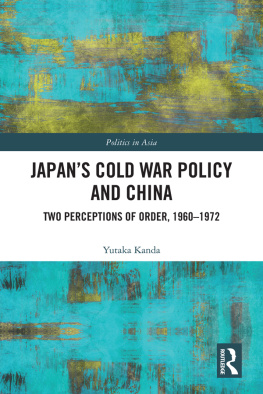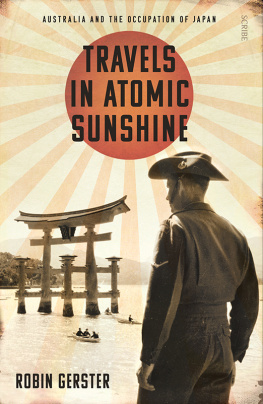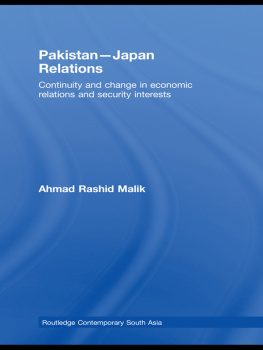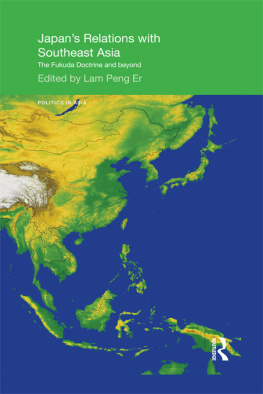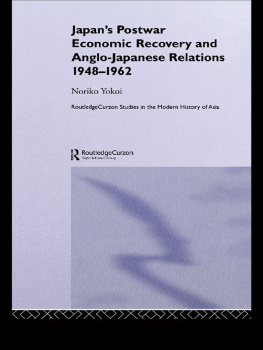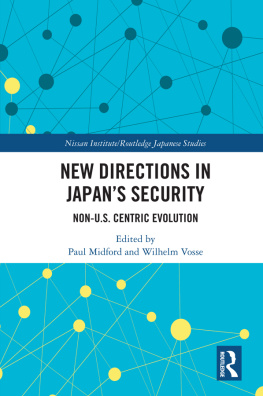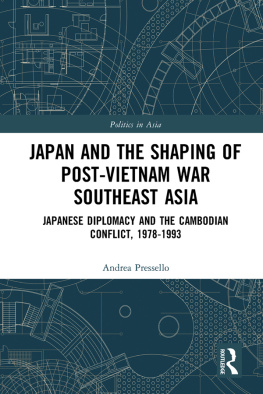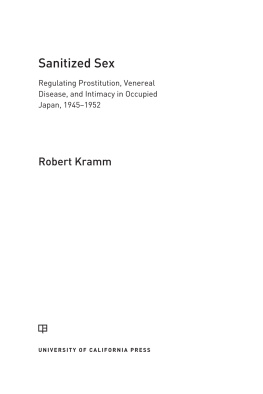THE AMERICAN OCCUPATlON OF JAPAN
THE AMERICAN OCCUP ATION OF JAPAN
The Origins of the Cold War in Asia
MICHAEL SCHALLER

Oxford University Press
Oxford New York Toronto
Delhi Bombay Calcutta Madras Karachi
Petaling Jaya Singapore Hong Kong Tokyo
Nairobi Dar es Salaam Cape Town
Melbourne Auckland
and associated companies in
Beirut Berlin Ibadan Nicosia
Copyright 1985 by Oxford University Press, Inc.
First published in 1985 by Oxford University Press, Inc.,
200 Madison Avenue, New York, New York 10016
First issued as an Oxford University Press paperback, 1987
Oxford is a registered trademark of Oxford University Press
All rights reserved. No part of this publication may be reproduced,
stored in a retrieval system, or transmitted, in any form or by any means,
electronic, mechanical, photocopying, recording, or otherwise,
without the prior permission of Oxford University Press, Inc.
Library of Congress Cataloging in Publication Data
Schaller, Michael
The American occupation of Japan.
Bibliography: p.
Includes index.
1. United StatesForeign relationsJapan. 2. JapanForeign relations
United States. 3. United StatesForeign relationsAsia, Southeastern.
4. Asia, SoutheasternForeign relationsUnited States. 5. Japan
HistoryAllied occupation, 19451952. 6. United StatesForeign
relations19451953. 1. Title.
E183.8.J3S29 1985 327.73052 858818
ISBN 0195036263
ISBN 0195051904 (pbk.)
4 6 8 10 9 7 5 3
Printed in the United States of America
For Sue and Nicholas
PREFACE
On October 1, 1945, Foreign Service Officer John K. Emmerson began his formal duties in Tokyo by moving into the newly requisitioned offices of a major Japanese corporation. He arrived just as a Mitsui junior executive was clearing the last items from his desk, the diplomat later recalled. Before leaving, the displaced manager pointed to a map on the wall depicting Japans Co-Prosperity Sphere. There it is, he said smiling. We tried. See what you can do with it! For Emmerson, who had spent the previous year interrogating Japanese prisoners of war (POWs) in China, the words had a tremendous impact. At that moment, he noted, the whole burden of American foreign policy in Asia hit me in the stomach. What were we going to do with it?
By the spring of 1950, with the United States struggling to restrain the sweep of Communist revolution over Asia, the prophetic quality of these words seemed quite real. Diplomats such as George F. Kennan spoke openly of a need to create for Japan a new empire to the South. That April, Japans feisty, conservative prime minister, Yoshida Shigeru, discussed with one of Emmersons successors the American pressure on Tokyo to accept a peace treaty that excluded China and the Soviet Union, yet granted the United States post-Occupation bases. Not only his left-wing critics but his right-wing colleagues as well, Yoshida complained, opposed what they saw as a willingness to subordinate Japanese interests to Americas cold war policies. The prime ministers response sought to placate these criticisms by predicting that just as the United States was once a colony of Great Britain but is now the stronger of the two, if Japan becomes a colony of the United States it will also eventually become the stronger.
Although the verdict on Yoshidas prophecy can be disputed, few question that U.S. policy toward Japan after the Second World War, like that toward its Axis partner Germany, stands out as one of the few triumphs in postwar diplomacy. Unlike the clouded, even tragic, American crusades in China, Korea, and Vietnam, the legacy of the Occupation seems one of progress, prosperity, peace, and democracy. Even more unusual, this achievement took place under the supervision of Americas most controversial military hero, Gen. Douglas MacArthur.
Although most accounts of the Occupation portray it as a unique and distinct event in postwar diplomacy, the spectacle of Japans recovery from disaster confirmed more trends in cold war history than it contradicted. Americas handling of both Axis partners cannot be understood without examining the political, economic, and military crises that swept over the world after 1945. The break in SovietAmerican relations, the economic collapse in Western Europe and Japan, the surge of Asian nationalism, and the Chinese Revolution all provided the context in which MacArthur, the Truman administration, and the Japanese themselves charted an uncertain course. Planning and implementing Occupation policies never occurred in a vacuum, before or after surrender. Conversely, concern for Japans future shaped aspects of the most controversial American actions in postwar Asia, such as the interventions in China, Korea, and Vietnam.
Even before the atomic bombs fell in August 1945, policymakers in Washington pondered how to exercise control in Asia through the deft manipulation of Chinese, Southeast Asian, and Japanese aspirations. But the tide of revolutionary nationalism engulfing this vast region outraced all presurrender predictions, forcing the Truman administration toward new strategies. Once resolved to implement a containment program along Chinas periphery, the United States rebuilt Japan as the pivot of what American officials called the Great Crescent, a barrier of anti-Communist states stretching from Hokkaido to Pakistan. Usually described as a series of offshore island strongpoints, this defense perimeter actually encompassed a complex network of economic, geographic, political, and military relationships. Moreover, from the middle of 1947 through the outbreak of the Korean War, most of President Harry S. Trumans advisers considered MacArthurs handing of the Occupation more an impediment to recovery and security than an asset. Increasingly, his personal agenda and political ambitions deviated sharply from the ways both civilian and military leaders in Washington envisioned Japans future.
The decision of the Truman administration in 194748 to initiate a Japanese recovery program modeled on the Marshall Plan brought about a direct clash between the flamboyant Supreme Commander and almost all agencies in Washington. In defiance of MacArthur, the State and Defense departments halted many basic Occupation reforms in pursuit of economic recovery and political stability. This recovery drive also spurred growing concerns about where Japan would find suitable markets and raw materials, especially in light of Chinas revolution, Southeast Asian rebellions, and Tokyos chronic dollar shortage. Without fully anticipating the consequences, the American government implemented a program in Asia that reflected a desire for Japan to serve as the hub of a new regional alliance.
This study does not pretend to dwell on the remarkable internal transformation of Japan during the Occupation years. That is, in great measure, another and equally important story. I have tried to place the Occupation in the context of overall American East Asian diplomacy from 1945 to 1950, an approach that reveals a long-obscured relationship between the successful centerpiece of American policy and the dubious campaigns to secure the great crescent. In short, it provides a novel perspective on the origins of the cold war in Asia.
Tucson, Arizona
January 1985
M.S.
ACKNOWLEDGMENTS
Many friends, institutions, and organizations have assisted in this project. Leonard Dinnerstein, Robert Schulzinger, Akira Iriye, Walter LaFeber, Robert M. Blum, Lloyd Gardner, William W. Stueck, and Bruce Cumings all read the manuscript in part or whole, making suggestions for improvement for which I am indebted. Howard Schonberger, William S. Borden, and especially John W. Dower deserve special thanks. They shared a wealth of knowledge on this subject, allowed me to read their own works in progress on related issues, and scrutinized early drafts with tremendous care. I first explored some of these themes in a paper jointly written with James Elston for the Amherst Conference on Occupied Japan.
Next page


